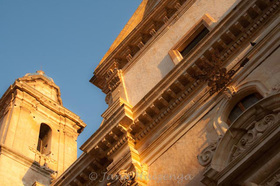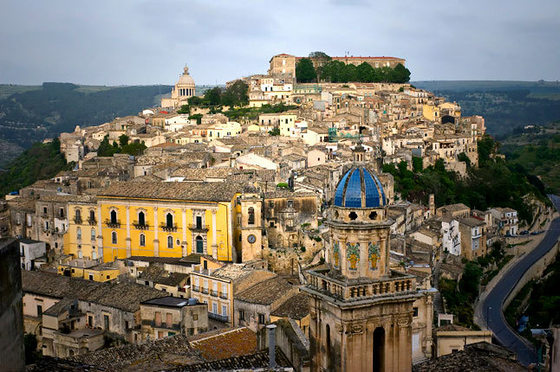The first thing you learn about Sicily, one of the first, anyway, is that it's a living museum of baroque architecture. In the interior, sure, you find plenty of stone farmhouses and ancient olive trees, but in the towns and villages of the coast, it's all curlicues. The exuberance and ostentation of Baroque architecture was encouraged by the Church as a way to communicate the glory of God to the faithful. The dour lines of German buildings, home to Luther's Reformation, were gloomy and unadorned, but Baroque was (and still is) an expression of joy.
 Baroque architecture has survived on the island partly because, well, Sicily is an island. A Cinderella neglected by its siblings in the wealthy cities of Italy's northern provinces. It is breathtaking to round a corner and come upon such ornate churches or civic buildings. The American photographer Jann Huizenga, whose pictures illustrate this post, has made her home in the village of Ragusa Ibla, calls her blog Baroque Sicily, and it's well worth your while to sign up for her newsletters.
Baroque architecture has survived on the island partly because, well, Sicily is an island. A Cinderella neglected by its siblings in the wealthy cities of Italy's northern provinces. It is breathtaking to round a corner and come upon such ornate churches or civic buildings. The American photographer Jann Huizenga, whose pictures illustrate this post, has made her home in the village of Ragusa Ibla, calls her blog Baroque Sicily, and it's well worth your while to sign up for her newsletters.
The New York Times had a photo spread this weekend about a place near Ragusa called Scicli where there's a $4.8 million, 12-bedroom villa for sale. Turns out Huizenga had already photographed and blogged about the village -- "Shabby Scicli" she called it -- and knew about the villa, which, she wrote to me, "used to be a hotel, started by a pair of Frenchmen. It's gorgeous."
No one doubts that rural Sicily has the charm of a land forgotten by time. Urban Sicily's another story. Just try to cross the Via Roma in Palermo at rush hour: a swarm of tiny Fiats and husky Vespas (their drivers with a cellphone in one hand, a cigarette in the other) and a cacaphony of horns and shouts. Still, there's a vitality that can't be ignored.
Tonight is Epiphany, celebrated across Europe. In Italy, it's the visit of the Befana, an old woman who leaves gifts for children: a carmelle (candy) if you've been good, a carbone (lump of coal) if not.

Leave a comment